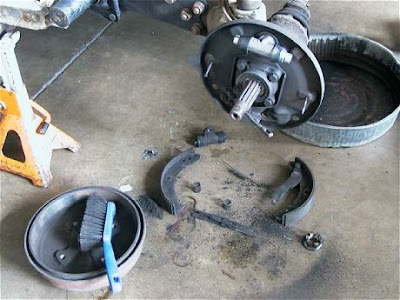
Beetles manufactured prior to May of 1950 had mechanically operated brakes; all Beetles made from that date have hydraulic braking systems. Because of the comparative rarity of pre-] 950s cars, this book covers only hydraulic systems. Owners of Beetles with mechanical brakes will find the details they need in the specialised workshop manuals dealing with early Beetles.
In essence the Beetle, in common with most cars, has two separate brake operating mechanisms. The handbrake is operated mechanically and acts only on the rear wheels whilst the footbrake acts on all four wheels using hydraulic pressure. When the brake pedal is depressed, a piston moves within a cylinder (the master cylinder) which contains non-compressible brake fluid. Because this liquid cannot be compressed, this action pushes it Acing a series of pipes and hoses to smaller cylinders containing pistons (the wheel cylinders and pistons in the case of drum brakes and the callipers and pistons for disc brakes), so placing pressure against the secondary piston and causing it to move.
The secondary pistons press shoes (drum brakes) or pads (disc brakes) against the drum or disc respectively; these are mechanically fastened to the rotating road wheels. The friction between shoe/dr4un pad/disc causes the road wheel's speed of rotation to slow, so slowing and stopping the car.
If you are undertaking a bodyshell-off restoration, then unless the brake pipes have obviously been recently replaced (and are not kinked). it is worth renewing them whilst accts is good. if you intend keeping the car for any great length of time then consider fitting the more expensive nickel-copper alloy brake pipes, which should last as long as the car. Because it is highly likely that most people who are restoring a Beetle will wish to completely overhaul the braking system, this entire section is devoted to a full brakes overhaul.
It is important to stress that when working with the braking system. cleanliness is vital: keep all lubricants well away from discs, drums, shoes and pads, and do not allow the brake fluid to become contaminated.
In essence the Beetle, in common with most cars, has two separate brake operating mechanisms. The handbrake is operated mechanically and acts only on the rear wheels whilst the footbrake acts on all four wheels using hydraulic pressure. When the brake pedal is depressed, a piston moves within a cylinder (the master cylinder) which contains non-compressible brake fluid. Because this liquid cannot be compressed, this action pushes it Acing a series of pipes and hoses to smaller cylinders containing pistons (the wheel cylinders and pistons in the case of drum brakes and the callipers and pistons for disc brakes), so placing pressure against the secondary piston and causing it to move.
The secondary pistons press shoes (drum brakes) or pads (disc brakes) against the drum or disc respectively; these are mechanically fastened to the rotating road wheels. The friction between shoe/dr4un pad/disc causes the road wheel's speed of rotation to slow, so slowing and stopping the car.
If you are undertaking a bodyshell-off restoration, then unless the brake pipes have obviously been recently replaced (and are not kinked). it is worth renewing them whilst accts is good. if you intend keeping the car for any great length of time then consider fitting the more expensive nickel-copper alloy brake pipes, which should last as long as the car. Because it is highly likely that most people who are restoring a Beetle will wish to completely overhaul the braking system, this entire section is devoted to a full brakes overhaul.
It is important to stress that when working with the braking system. cleanliness is vital: keep all lubricants well away from discs, drums, shoes and pads, and do not allow the brake fluid to become contaminated.



